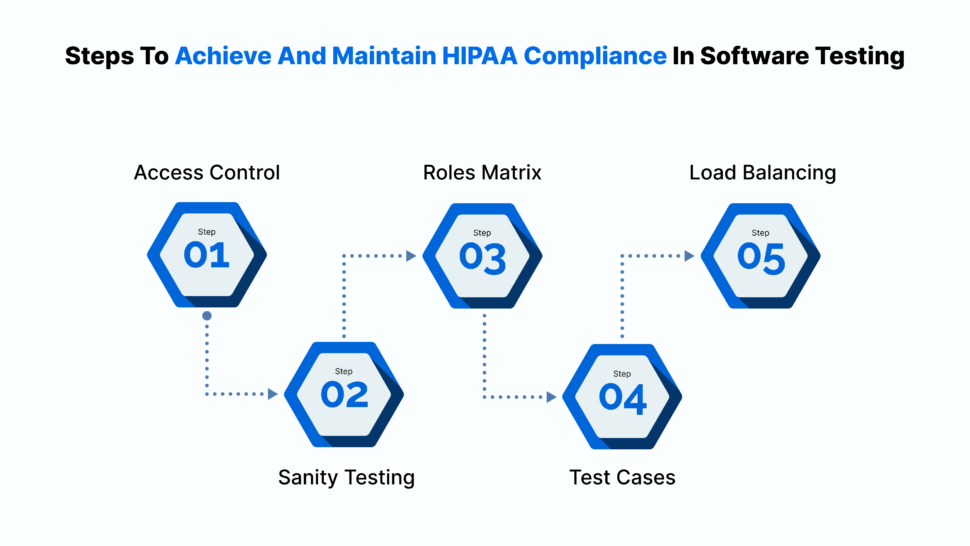Imagine HIPAA as a superhero guarding your personal health information. For almost 30 years, it’s been watching over the vast market of healthcare software, making sure things run clean and private. But here’s the thing: not all healthcare companies are like eager trainees wanting to join the ranks of HIPAA champions.
Some just don’t see the point of getting their tech all HIPAA-ready, while others lack the skills or super-gadgets to build apps strong enough to keep your health data safe.
Unfortunately, this has resulted in a bad statistic: more than 231 million Americans have become victims of healthcare data breaches!
Now, imagine companies facing huge fines for messing up with HIPAA. They not only lose a lot of money but also damage their reputation, worse than a villain’s breath. Patients and partners run away, and trust drops to zero.
But there’s good news! This isn’t a helpless situation. We have a secret weapon against data breaches: HIPAA compliance software Development. Think of it as a detective with tech skills, finding and fixing any problems in healthcare software defenses before bad people can take advantage of them.
By letting these detectives do their job, companies can ensure their software is HIPAA-proof, keeping your health data safe and sound. No more fines, no more shattered reputations, just happy patients and secure records.
So, the next time you interact with any healthcare app, remember: to ask if it’s been through the rigorous training of HIPAA compliance testing. Because in the battle for your health data’s safety, every shield and sword counts!
What is HIPAA?

HIPAA, or the Health Insurance Portability and Accountability Act of 1996, is a law in the United States that tells healthcare providers how to handle their patients’ data. It was made for several reasons, but the most important ones are to keep patient health information safe and make sure only authorized people can access it.
Also, HIPAA played a big role in moving from paper to digital for managing and sharing patient records.
Let’s break it down:
- Health Insurance Portability: This part ensures you can keep your health insurance even if you switch jobs or lose your current one.
- Accountability: This part holds healthcare organizations accountable for keeping your health data safe and private. It tells them: “Don’t you dare share that info without my permission!
So, when you go to the doctor, visit a hospital, or use a healthcare app, HIPAA makes sure your medical records stay confidential and protected. No one can share it with anyone else without your say-so unless it’s for specific reasons like treating you or preventing harm.
Importance of building a HIPAA compliance software
In today’s digital healthcare landscape, building HIPAA-compliant software is not just an option, it’s a necessity. Here’s why it’s so important:
Protecting Patient Data
HIPAA, or the Health Insurance Portability and Accountability Act, is a law that aims to protect important patient information, called protected health information (PHI). PHI covers things like medical records, diagnoses, billing details, and social security numbers.
Protected Health Information (PHI): Protected health information (PHI) is any information in the medical record or designated record set that can be used to identify an individual and that was created, used, or disclosed in the course of providing a health care service such as diagnosis or treatment.
Source: Berkeley Human Research Protection Program
Creating software that follows HIPAA rules ensures the privacy and security of this crucial data, keeping patients safe from unauthorized access, breaches, and potential harm.
Building Trust and Confidence
Healthcare information is very private, and patients rightly want it to be kept confidential. When you decide to create software that follows HIPAA rules, you show that you’re dedicated to keeping their information private and following ethical standards.
This builds trust and confidence, improving relationships between patients and healthcare providers, ultimately leading to better healthcare results.
Avoiding Legal and Financial Consequences
Not following HIPAA rules can lead to big problems, like expensive fines, getting sued, and harm to your reputation. Creating software that follows HIPAA rules right from the start lowers these risks, saving you time, money, and potential legal troubles.
Encouraging Innovation and Teamwork
HIPAA-compliant software can facilitate secure data exchange and collaboration between healthcare professionals, organizations, and research institutions. This unlocks the potential for personalized medicine, data-driven insights, and improved healthcare delivery models.
Compliance as a Competitive Advantage
In a busy healthcare market, making patient privacy and data security a top priority can make you stand out from the competition. Using software that follows HIPAA rules shows that you’re serious about doing things ethically and handling data responsibly. This builds trust and loyalty from both patients and healthcare providers.
Putting resources into HIPAA compliance means investing in patient trust, safeguarding your reputation, and contributing to the future of healthcare. Adopt it not just because it’s a law, but because it’s the right and ethical choice.
Why is building a HIPAA-compliant software difficult?

Creating software that follows HIPAA rules is not easy. It’s like doing a careful dance between making the software work well and keeping it secure. Each step needs careful attention to avoid breaking the complex rules. Here are some important reasons why it’s challenging:
Privacy of Data
In healthcare, data is crucial, and HIPAA has strict rules about how it’s used and shared. Developers always have to think about keeping patient information private, making sure there are proper ways to get permission, and stopping anyone from accessing or sharing it without permission.
Stringent Security Requirements: HIPAA demands robust security measures like encryption, access controls, logging, and audit trails. Implementing these features seamlessly requires extensive technical expertise and careful planning.
Constant Rule Changes
HIPAA keeps changing. New rules and ways to understand them come up often, so software needs updates to follow the rules. This requires developers to be quick and flexible.
Lack of Awareness and Expertise
Not every developer knows the ins and outs of HIPAA’s technical details. Developing software that meets compliance standards demands specific expertise and experience, which may not be easy to find and can be costly to acquire.
Balancing Ease and Safety
Healthcare professionals need interfaces that are easy to use. But some security steps, like strong logins or complicated ways to get data, can make it less user-friendly. Finding the right mix is always a challenge.
Testing and Validation
Ensuring HIPAA compliance isn’t a one-time task. Rigorous testing and validation are necessary to identify and address vulnerabilities. This adds an extra layer of complexity and cost to the development process.
No Clear Directions
Figuring out what HIPAA rules mean can be open to interpretation, and confusing. Developers should ask legal and compliance experts for help to handle these complicated situations.
Even though it’s tough, making software that follows HIPAA rules is important for the future of healthcare. If we focus on keeping things secure and private and following the rules, we can make sure that important patient information is safe. This helps provide better care and makes people healthier.
Keep in mind that following HIPAA rules is a continuous process, not a one-time thing. Face the challenges and invest in the right knowledge to create software that’s both secure and follows the rules. This way, you can build trust for both healthcare professionals and patients.
Strategies and Areas for HIPAA software testing
Ensuring HIPAA compliance in software requires rigorous testing throughout the development lifecycle. Here are some key strategies and areas to focus on:

Strategies:
Smart Testing:
Prioritize checking the most important parts based on how sensitive the data is and how much harm could happen if there are problems. Start by looking closely at the features that deal with protected health information (PHI).
Black-box and white-box testing:
Use both internal (white-box) and external (black-box) testing viewpoints to find various kinds of weaknesses.
Automated and manual testing:
Utilize a mix of automated and manual testing methods for both efficiency and comprehensive coverage. Automate repetitive tasks but manually test complex scenarios and user interactions.
Continuous testing:
Include testing at every step of creating the software, not just at the end. This helps find and fix problems early, saving time and effort.
Threat Planning:
Look ahead to find possible problems and ways someone might try to break in. Use this information to guide your testing and make sure you check everything thoroughly.
Areas:
User authentication:
Check how users log in, get permission, and what they’re allowed to see, making sure only authorized users can access protected health information (PHI).
Data security:
Check how data is turned into code, sent securely, and stored properly to make sure it stays private and unchanged.
Audit trails:
Check how the system records what users do and keep a trail to make sure we can see who did what with the data. This helps make sure people are accountable for accessing and changing information.
Penetration testing:
It is like practicing real attacks on the software to find and fix any weaknesses or problems in its defenses.
Usability and workflow:
Verify that the software is user-friendly and does not inadvertently encourage privacy violations or security risks due to cumbersome workflows.
Compliance checks:
Keep checking and improving testing procedures to match the latest HIPAA rules.
By implementing these strategies and focusing on these areas, you can ensure your HIPAA software testing is comprehensive and effective, minimizing the risk of non-compliance and protecting sensitive patient data.
Remember, HIPAA compliance is an ongoing process, not a one-time effort. Remain vigilant and continuously adapt your testing approach to maintain a secure and compliant software solution.
Steps to achieve and maintain HIPAA compliance in software testing
Reaching and keeping HIPAA compliance in software testing needs a steady and ongoing approach. Here are some important steps to follow:
Access Control
To follow HIPAA rules, users should only access the information they need for their job. This strict control can be achieved through seven methods
- A list that specifies which parts of the system users can access.
- Giving each user a unique name and number for tracking.
- Requiring two-factor authentication for login.
- Giving access based on a user’s role.
- Limiting access based on time, date, or network.
- Having a special process for emergencies to gather important health information.
- Automatically logging off if the system is inactive for a set time.
- Securing health information by encrypting and decrypting it.
Sanity testing
First, in the testing plan for following HIPAA rules, we do a basic check-called a sanity test. We examine the app to find any issues with meeting HIPAA standards.
Here’s what we look at:
We make sure that users with important roles can easily log in and have the right access to view, change, or delete information in specific parts of the app. Everything they do is recorded.
We check if the information in the audit trail and the database is properly encrypted, especially for things like health information (EPHI).
Roles matrix
If the app uses role-based access, it’s crucial to figure out the roles in the system and what they can do in the app.
We make a chart that shows different roles based on how much risk the client sees in sharing information, how often the app is used, the chances of mistakes, and how bad those mistakes could be. This chart helps us figure out how risky each relationship is and lets us fix problems before they become bigger issues.
Test cases
The next thing we do in testing the software for HIPAA compliance is to create detailed test cases. This means breaking down what the user does into specific actions and the expected results such as signing in, handling available time slots, checking scheduled appointments, joining virtual consultations, and managing profiles.
Load balancing
Having backup plans or balancing the workload is super important for healthcare organizations. If a patient’s data is lost, it can cause big problems. These plans make sure the software keeps working every day while also making backups. They check if the software can use resources when needed and spot urgent situations.
When a good backup plan is set up right and tested well, it should almost completely protect data, prevent much or any loss, and quickly recover from errors.
The cost of HIPAA compliance testing

The cost of HIPAA compliance testing can vary widely depending on several factors, including:
The size and complexity of your organization:
If a company is big with lots of people and data to safeguard, the cost of testing is usually higher compared to smaller companies.
The type of software being tested:
Checking and ensuring the security of software that is specifically made for a particular organization usually costs more than testing software that is ready-made and available for everyone to use.
The scope of the testing:
If you want a thorough check of your software that includes trying to break in, looking for weak points, and manual testing, it will be more expensive than a basic review to see if it meets the standard rules.
The experience and expertise of the testing firm:
Companies that have more experience and a good reputation might ask for more money, but they can also give you a more detailed and valuable assessment of your software.
Here’s a rough estimate of the range of costs you might expect to pay for HIPAA compliance testing:
- Basic compliance review: $5,000-$10,000
- Vulnerability scanning and penetration testing: $10,000-$50,000
- Comprehensive HIPAA compliance assessment: $25,000-$100,000 or more
Below are some additional factors that may influence the expense of HIPAA compliance testing:
Location of the Testing Firm:
Companies in big cities might charge more than those in smaller towns.
Travel Requirements:
If the testing company has to come to your place for the assessment, you might have to cover their travel expenses.
Urgency of the Assessment:
If you need the assessment done quickly, it could affect the cost.
*Before choosing a testing company, make sure to get price estimates from a few different ones. Ask them about their experience with the HIPAA compliance software Development team, how they do it, and how much they charge*.
How Ailoitte can help in building HIPAA compliance software
Ailoitte understands the crucial importance of HIPAA compliance Application development. Here’s how their skills can assist you in creating secure and compliant solutions:
Deep Understanding of HIPAA
Ailoitte’s team possesses extensive knowledge and experience dealing with tricky HIPAA rules. They stay updated on the latest rules and interpretations to make sure your software follows what’s needed now and in the future.
Pre-Built HIPAA-compliant Features
Ailoitte offers pre-built modules and functionalities that already follow HIPAA standards. This saves your time and resources by giving a secure starting point for developing your software.
Security-Focused Development Process
Ailoitte puts security first in every part of making software. They use safe coding methods, check for problems regularly, and use strong ways to turn data into code and control who can access it.
Audits and Advice on Following Rules
Ailoitte can check your software inside to make sure it follows the rules (compliance) and fix any issues related to HIPAA. They also advise on how to build and keep following the rules as your software grows.
Experienced Project Management
Ailoitte’s project managers are skilled at handling complicated projects for software that follows HIPAA rules. They make sure things get done well and on time, and that the new software works smoothly with existing healthcare systems.
Training and Support
Ailoitte offers comprehensive training for your team on using and maintaining your HIPAA-compliant software. They also provide ongoing support to ensure you remain compliant and confident in your data security practices.
Proven Track Record
Ailoitte has a successful track record of building and implementing HIPAA-compliant software for healthcare organizations of all sizes. Their portfolio of satisfied clients is a testament to their commitment to excellence and compliance.
If you need help building or testing a healthcare application that follows HIPAA rules, contact us today.
FAQs
To make sure you’re following HIPAA rules and handling risks well, always install software updates right away. If you can, set up the software to update on its own.
HIPAA makes sure that any information shared with doctors, health plans, or created, sent, or stored by them has strong security rules. Patients also get to decide who can see and use their information.
If your software deals with health information (PHI), it’s really important to know and follow HIPAA rules. You need to put in place the necessary safeguards to protect this information and steer clear of the financial and legal troubles that come with not following the rules.
In simple terms, the Privacy Rule safeguards a specific set of personal health details, called protected health information (PHI). This includes information held by healthcare organizations or business partners working on their behalf, with some specific cases as exceptions.
If you store, collect, manage, or transmit any protected health information to covered entities then your app needs to be HIPAA compliant.


















.png)
.png)
.png)



Leave a Comment